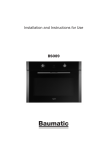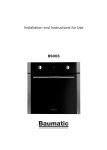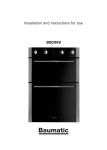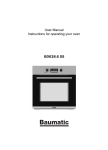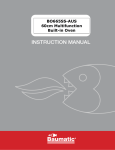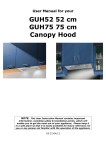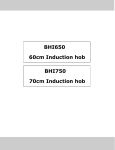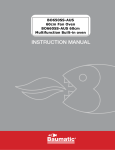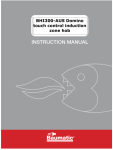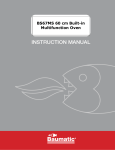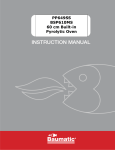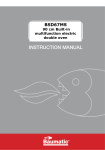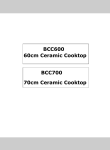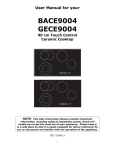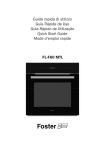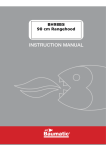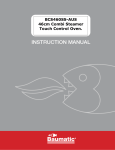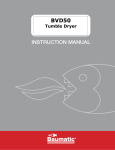Download Manual - Baumatic
Transcript
Installation and Instructions for Use BSPO610 SAFETY INSTRUCTIONS Read these instructions carefully to obtain the best performance from your oven. Keep this manual so that it can be read by a new owner. Electrical safety • The oven is supplied with a H05SS-F supply cord for connection to the power supply. • The oven must always have a good earth connection in line with current regulations. • Total disconnection from the mains installation must be incorporated when installing the oven, as specified in the installation regulations, (suitable for the heat intensity to be withstood and with a minimum space between contacts of 3 mm) following category III conditions for surges, for disconnection in case of emergency, for cleaning or for changing the light bulb. Under no circumstances should the earth wire pass through this switch. • This switch may be replaced by a plug, provided it is accessible for normal use. • If the supply cord is damaged, it must be replaced by the manufacturer, its service agent or similarly qualified persons in order to avoid a hazard. The connection diagram is shown in figure 12. • Any handling or repair to the appliance, including replacement of the power cable, should be carried out by authorised Technical Service Personnel using original 3 spare parts. Repairs or handling by others may damage the appliance or cause malfunctioning that could be hazardous to your safety. • Unplug or disconnect your oven if it malfunctions. Child Safety During use, the appliance becomes hot. Care should be taken to avoid touching heating elements inside the oven. WARNING: Accessible parts may become hot during use. To avoid burns, young children should be kept away. Accessible parts may become hot when the grill is in use. Children should be kept away. WARNING: This appliance is not intended for use by persons (including children) with reduced physical, sensory or mental capabilities, or lack of experience and knowledge, unless they have been given supervision or instruction concerning use of the appliance by a person responsible for their safety. Children should be supervised to ensure that they do not play with the appliance. Safety in the use of the oven • The oven must always be operated with the door closed. • Only use the oven after it has been installed inside the kitchen unit (See Installing the Oven). • The grid has a system enabling partial removal easy for handling food. 4 • The oven heats up when in use, so please use oven gloves when performing operations inside the oven and avoid touching the heating elements. • Only use the supplied temperature probe inside the oven (in models that come with this feature). Cleaning and Maintenance • Disconnect the appliance from mains power supply before any operation. • Do not use abrasive cleaning products, or steam or pressurised-water cleaning equipment. • Cleaning and maintenance tasks to be carried out by the user should not be done by children without supervision. • Before replacing a bulb, first make sure that the oven has been disconnected from the mains to avoid the possibility of receiving an electric shock. • Remove all accessories and dishes from the oven, including the shelf supports and/or telescopic guide rails. • Clean any spillages or excess dirt, as during the pyrolytic cleaning cycle these could ignite and become a fire hazard. • For your safety, never turn on the oven if the back panel that covers the fan is not in place. 5 Before First Use Other Important Instructions There may be traces of grease and other substances in the oven as a result of its manufacturing process. These should be removed by means of the following procedure: • The oven must always be operated with the • Remove all the packaging from your oven, including the protective plastic, if any. • Turn your oven to , or if this setting is not available to , at 200 ºC for 1 hour. Consult the Quick Start Guide accompanying this manual on how to do this. • Cool the oven with the door open so that it ventilates and no odours remain inside it. • Once cold, clean the oven and accessories. During this first operation, smoke and smells will be produced. The kitchen should therefore be well ventilated. door closed. • The manufacturer takes no responsibility for any use of the oven other than for the home preparation of food. • Do not store oil, fats or inflammable materials inside the oven. This may be dangerous if the oven is turned on. • Do not lean or sit on the open oven door. You could damage it, as well as endanger your own safety. • Do not cover the bottom of the oven with aluminium foil as this may affect cooking performance and damage the enamel inside the oven and the interior of your kitchen unit. • To cook any food, insert the tray or grid into the guide rails inside the oven. Environmentally Friendly Packaging • Do not place containers or food on the bottom The packaging is made from totally recyclable materials which can be put to other uses. Consult your local council regarding the necessary procedures for disposing of these materials. • Do not pour water on the bottom surface CAUTION The symbol on the product or packaging indicates that this appliance cannot be disposed of as normal household waste. It should be taken to an electrical and electronic equipment collection point for recycling. In this way, any negative consequences for the environment and public health from incorrect handling can be avoided. Contact your local council, household waste disposal service or the establishment where you bought the product from for more information on recycling the appliance. 6 surface of the oven. Always use the trays and grid. when in use; this may damage the enamel. • Open the oven door as little as possible during cooking. This will reduce power consumption. • It is normal for condensation to occur on the oven door when cooking dishes with a high liquid content. • Clean the oven interior to remove traces of grease or food, which could later give off smoke and odours and cause stains to appear. Safety when using the pyrolytic cleaning cycle During the pyrolytic cleaning process: Before the cleaning cycle starts you must: • Do not leave any cloths or fabric hanging • CAUTION: Remove all accessories and dishes from the oven, including the shelf supports and/or telescopic guide rails. • Clean any spillages or excess dirt, as during from the oven handle or in close contact with it. • For safety reasons, the hob must not be in use while the oven is in pyrolytic mode. the pyrolytic cleaning cycle these could ignite and become a fire hazard. • The oven’s inside light will remain off and • Remove any dirt from the oven gasket. • Carefully follow the instructions for program- • The oven is equipped with a safety lock ming the pyrolytic cleaning cycle. cannot be turned on. mechanism that will prevent the door from being opened during the cleaning cycle. Do not try to open the door while the lock is activated, as the pyrolysis programme may be halted. Cleaning and Maintenance Caution: Caution Disconnect the appliance from mains power supply before any operation. Do not clean the oven interior with steam or pressurised-water cleaning equipment. Do not use metal scouring pads, wire brushes or any utensil that can scratch the enamel. Clean the oven interior to remove traces of grease or food, which could later give off smoke and odours and cause stains to appear. Normal Cleaning Procedure for Oven Interior • Traces of grease or food in the oven can be cleaned normally. • Use nylon brushes or sponges with warm soapy water to clean enamelled surfaces such as the bottom of the oven. Clean when the oven is cold. Use oven-cleaning products only on enamelled surfaces and always follow the manufacturer’s instructions. 7 Pyrolytic Self-Cleaning Procedure Instructions to remove the shelf supports and/or telescopic guide rails. • This setting allows you to carry out a pyrolytic 1 Remove all accessories from inside the oven. cleaning cycle, which involves the oxidisation and carbonisation of the grease accumulated during cooking by means of the high temperatures that are reached inside the oven. • When the pyrolytic cleaning process has finished, it is only necessary to wipe the inside with a damp cloth, cleaning up the ash produced during the cycle. Areas in the oven that are difficult to access will need to be cleaned with a non-metallic fibre scourer so as not to scratch the enamel. • When programming the pyrolytic cleaning cycle, you will see that the oven has 3 pyrolysis programmes with 60, 90 and 120-minute cycles. Use the most suitable programme for the level of dirt in the oven. If the oven is very dirty it will require a longer programme. • Pyrolysis is not required after each use of the oven. We recommend that you carry out a pyrolytic cleaning cycle after every 4-5 uses, depending on how dirty the oven interior is. • During the cleaning cycle the light inside the oven will remain off. CAUTION: Before carrying out the pyrolytic cleaning cycle, you must remove all accessories and dishes from the oven, including the shelves and/or telescopic guide rails. 2 Pull on the supports or the telescopic guide rails (A), loosening the screw (B). Figure 1. To assemble the supports, place the ends of the supports in the lower holes in the sides of the oven interior and fasten them with the screw (B). Cleaning the Oven Exterior and Accessories Clean the outside of the oven and accessories with warm soapy water or with a mild detergent. Take great care when cleaning stainless steel or painted surfaces. Use only sponges or cloths that do not scratch. Cleaning the Oven Door Do not use metal scouring pads, wire brushes or commercially available or abrasive powder cleansers to clean the oven door as they could scratch the surface and cause the glass to break. Clean the door exterior and accessories with warm soapy water or with a mild detergent. Take great care when cleaning stainless steel surfaces. Use only sponges or cloths that do not scratch. You may also clean the inner glass of the oven door. To remove it, follow the instructions below. Instructions for Removing / Replacing Inner Glass 1 Open the oven door. 2 Insert the safety bolts supplied with this manual to stop the door from closing. IMPORTANT: Keep these bolts in a safe place and use them whenever you need to clean the oven door. Figure 2. 8 3 Apply pressure with your fingers on Point 1 located on the upper part of both sides of the oven door. Figure 3. 4 Without releasing the pressure applied to Point 1, pull on the plastic seal above the door. Figure 4. 5 The glass panels inside the door will loosen and can be easily cleaned with glass cleaner and a cloth. Caution If you have not inserted the safety bolts, be careful when you remove the inner glass as the oven door will shut. 6 Once they are clean, replace the glass panels in the same order so that you can read the printed TERMOGLASS labels on them. Figure 5. 7 Re-attach the plastic seal over the door, assuring that the side tabs fit in point 1. If Something Goes Wrong The oven stops working Check the power connection. Check the fuses and the circuit breaker of your installation. Make sure the timer is either in the manual or programmed setting. Check the position of the control and temperature dial. The inside light does not go on Change the bulb. Check that it has been properly inserted according to the Instruction Manual. The heating pilot light does not turn on Changing the Oven Light Bulb WARNING: Ensure that the appliance is switched off or unplugged before replacing the lamp to avoid the possibility of electric shock. • Detach the chrome supports or the telescopic guide rails by loosening the screw (C). Figure 6. • Release the glass cover of the bulb-holder with a tool. • Change the bulb. • Reassemble the glass cover and ensure that Select a temperature. Select a setting. It should only come on while the oven is heating up to the selected temperature. Oven smoking during use Normal during first use. Clean the oven regularly. Reduce the amount of fat or oil in the tray. Do not cook at temperatures higher than those indicated in the cooking chart. everything fits in the correct position. Figure 8. The replacement bulb must withstand temperatures up to 300 ºC. You can order one from the Technical Assistance Service. The expected cooking results are not achieved Check the cooking charts for guidance on how your oven operates. Caution If these problems persist despite these tips, contact Technical Service. 9 Technical Specifications If the appliance does not work, inform Technical Service of the kind of problem you are experiencing and give the: 1 Serial Number (S-No) • The unit material, including covering materials and glue must be able to withstand temperatures of 120 ºC. Electrical Connection 2 Model of Appliance (Mod.), which you will find engraved on the identification plate. This plate is located on the bottom of the oven and can be seen when opening the door. The installer must ensure that: • The mains power voltage and frequency correspond to what is marked on the identification plate. • The domestic wiring system can withstand Installation This information is exclusively for the installer who is responsible for assembly and electrical connection. If you install the oven yourself, the manufacturer will not accept liability for possible damage. Prior to Installation the maximum power marked on the identification plate. • After connecting the power, check that all electrical parts of the oven are working correctly. • Disconnection from the electrical supply must be allowed after the oven is in the installed position. Oven Installation After connecting the power to the oven: Please refer to electrical safety instructions on page 3 of this manual before installation. • To unpack the oven, pull on the tab located at the bottom of the box and hold it by the side handles, never by the oven door handle. • The installation instructions must be adhered to strictly. If not, the oven’s ventilation circuit may become blocked, causing high temperatures that could damage the kitchen unit and the appliance itself. • The opening in the kitchen unit must be that indicated in Figures 8, 9 and 10, depending on the type of installation. The minimum size of the unit base must be 580 mm. • The rear of the unit, corresponding to the shaded area (A) in Figure 11 must have nothing projecting from it (unit reinforcement, pipes, sockets, etc.). 10 1 Position the oven inside the unit and ensure that the power cable is not trapped or in contact with parts of the oven that heat up. 2 Position the oven at the centre of the unit so that there is a separation of at least 5 mm between the oven and the adjacent units. Figures 13 and 14. 3 Anchor the oven to the unit with the two screws supplied, screwing them into the unit through the two holes that can be seen when the door is open. Control Panel 1 2 3 4 Ok 1 Function selector. 3 Electronic clock. 2 Door lock. When this pilot light is on, it indicates that the oven door is locked and cannot be opened. 4 Temperature selector. Oven Functions Switch off oven Conventional It is used for sponges and cakes where the heat received must be uniform to achieve a spongy texture. Conventional with fan Appropriate for roasts and cakes. The fan spreads the heat uniformly inside the oven. Grill For preparing dishes with superficial roasting. It allows the outer layer to be browned without affecting the inside of the food. Ideal for flat food, such as steaks, ribs, fish, toast. MaxiGrill Allows greater surfaces to be prepared, than with the grill, together with higher power reducing the time required for browning of the food. MaxiGrill with fan Allows uniform roasting at the same time as surface browning. Ideal for grills. Special for large volume pieces, such as poultry, game, etc. It is recommended to put the item on a rack with a tray beneath to collect the stock and juices. Caution While using the Grill, MaxiGrill or MaxiGrill with fan, the door must be kept closed. Turbo The fan distributes the heat coming from an element located at the back of the oven. As a result of the evenly distributed temperature, food can be cooked on two levels at the same time. Lower Element with Turbo Ideal for baking pizzas, pies, and fruit tarts or sponges. 11 Lower element Heats only from beneath. Suitable for heating dishes and raising pastry and similar. Defrosting This cooking mode is suitable for gently defrosting of food. In special food to be consumed unwarmed, e.g.: cream, custard, pastry, tarts, cakes, fruit, etc. Pyrolytic Function This programme allows you to carry out a pyrolytic cleaning cycle which involves the oxidisation and carbonisation of grease accumulated during cooking, through the high temperatures that are reached inside the oven. During the cleaning cycle the light inside the oven will remain off. NB The light remains on through all cooking functions except the pyrolytic function. Using the Oven Caution Manual Operation The electronic clock features Touch-Control technology. To operate, simply touch the glass control symbols with your fingertip. The oven is ready to be used when the clock has been set. Select a cooking function and a temperature. The touch control sensitivity continuously adapts to ambient conditions. Make sure the glass surface of the control panel is clean and free of obstacles when plugging in the oven. When you begin cooking, symbol lights up to indicate that the oven is heating the contents; the symbol goes out when the selected temperature is reached. If the clock does not respond correctly when you touch the glass, unplug the oven for a few seconds and then plug it in again. Doing this causes the sensors to adjust automatically so that they will react once more to fingertip control. Set the controls to to turn the oven off. Functions of the Electronic Clock Alarm: Creates an alarm signal when the period of time finishes; the oven does not need to be in use in order to use this function. Setting the time on the Electronic Clock When the oven is connected to the power supply, the indication 00:00 flash on the display. Press or to set the time on the clock. The clock beeps twice to confirm the selected time. If you wish to modify the time, press or until the current time flash on the screen. Press OK. Then press or to modify the time. The clock beeps twice to confirm the modification. 12 Cooking Time: To cook for a selected length of time; the oven turns itself off automatically when the time finishes. End Cooking Time: To cook until a set time; the oven turns itself off automatically when the time finishes. Cooking time and End Cooking Time: To cook for a selected length of time and end at a set time. When this function is set, the oven comes on automatically at the time required in order to cook for the set length of time (Cooking time) and end automatically at the indicated time (End Cooking Time) until symbol lights up. Press OK. 2 Set the period of time after which you wish the alarm to sound by pressing or . 3 The clock beeps twice, the current time is displayed and symbol lights up permanently to indicate that the alarm has been set. 4 When the set period of time comes to an end, the alarm sounds and symbol starts to flash. 5 Press any button to stop the alarm; symbol goes out. You can consult the remaining time at any moment by pressing or until symbol flashes and then pressing OK. You can also modify the set time at this point by pressing or . The clock beeps twice to confirm the change. If you wish the remaining time to be displayed until the end of the set period of time, press or until symbol flashes and then press OK and keep it pressed in. Symbol flashes. Keep OK pressed in again to return to the real time. Setting the Cooking Time 1 Press or Press OK. 5 When the cooking time comes to an end, the oven turns itself off, the alarm sounds and symbol flashes. 6 Press any button to stop the alarm and turn the oven back on again. 7 Set the controls to Programming the Alarm 1 Press 4 Select a cooking function and temperature. until symbol lights up. 2 Select the period of time you wish to cook for by pressing or . 3 The clock beeps twice, the current time is displayed and symbol lights up permanently to indicate that the oven will turn itself off automatically. to turn the oven off. You can consult the remaining cooking time at any moment by pressing or until symbol flashes and then pressing OK. You can also modify the set time at this point by pressing or . The clock beeps twice to confirm the change. If you wish the remaining time to be displayed until the end of the set period of time, press or until symbol flashes and then press OK and keep it pressed in. Symbol flashes. Keep OK pressed in again to return to the real time. Setting the End Cooking Time 1 Press or Press OK. until symbol lights up. 2 Select the time you wish the cooking process to finish at by pressing or . 3 The clock beeps twice, the current time is displayed and symbol lights up permanently to indicate that the oven will turn itself off automatically. 4 Select a cooking function and temperature. 5 When the set time is reached, the oven turns itself off, the alarm sounds and symbol flashes. 6 Press any button to stop the alarm and turn the oven back on again. 7 Set the controls to to turn the oven off. You can consult the end cooking time at any moment by pressing or until symbol flashes and then pressing OK. You can also modify the end cooking time at this point by pressing or . The clock beeps twice to confirm the change. 13 This function can be used even when you are already using the oven. To do this, follow the instructions indicated above except point number 4. Setting the Cooking Time and the End Cooking Time 1 Press or Press OK. until symbol lights up. 2 Select the period of time you wish to cook for by pressing or . 3 The clock beeps twice, the current time is displayed and symbol lights up permanently. 4 Press or Press OK. until symbol lights up. 5 Select the time you wish the cooking process to finish at by pressing or . 6 The clock beeps twice, the current time is displayed and symbol lights up permanently. 7 Select a cooking function and temperature. 8 The oven remains off with symbols lit up. Your oven is set. and 9 When the time to start cooking is reached, the oven starts up and cooks for the set period of time. 10 When the set end cooking time is reached, the oven turns itself off, the alarm sounds and symbols and flash. 11 Press any button to stop the alarm and turn the oven back on again. 12 Set the controls to to turn the oven off. You can modify the end cooking time by pressing or until symbol lights up and then pressing OK. You can now modify the end cooking time by pressing or . The clock beeps twice to confirm the change. 14 Child Safety Function This function can be selected at any time while using the oven. To activate the function, press the + and – sensors at the same time for several seconds. You will hear a beep and the display will show the word SAFE. The clock is locked. If the oven is off and you activate the child safety function, it will not work even if a cooking function is selected. If this function is activated while you are cooking, it will only lock the electronic clock settings. If a clock sensor is touched while the child safety function is on, the word SAFE will appear on the display. The clock is locked. To disable the function, press the + and – sensors at the same time for several seconds until you hear a beep. Important In the event of a power cut, all the electronic clock settings are deleted and the indication 00:00 flashes on the display. It is necessary to set the time and programme the clock again. PROGRAMMING AND OPERATING THE PYROLYTIC FUNCTION Follow the instructions below to complete a pyrolytic cleaning cycle: IMPORTANT: Remove all accessories (trays, grills, tray side supports, telescopic guide rails) from inside the oven. 1. Ensure all major food residues are removed from the oven and thoroughly clean the inner door glass. 2. Turn the cooking control dial to the Pyrolytic position . You will hear a beep which confirms this function has been chosen. 3. You will then see a P (pyrolytic programme) on the timer display together and the symbol will flash. 4. Press the + or – sensors to select one of the pyrolytic programmes (P1, P2 or P3). P1: Minimum programme (lasts 1 hour). P2: Standard programme (lasts 1.5 hours). P3: Maximum programme (lasts 2 hours). 5. After a couple of seconds, you will hear 2 beeps confirming the pyrolytic programme chosen. 6. After a short time, the pilot light will turn on and the oven door will be locked. 7. The oven will start to heat up and the symbol will appear permanently. The timer display will show the time remaining until the end of the programme. IMPORTANT: At this point, the oven is programmed and the pyrolitic cleaning cycle is underway. During the cycle, none of the oven timer functions may be chosen. Do not try to open the oven door as this may interrupt the cleaning process. 8. When the pyrolytic cleaning cycle has finished, an alarm will sound and the symbol will flash. 9. Press any of the timer keys to turn the alarm off. The symbol will disappear. 11. Although the oven’s heating process has ended, it is extremely hot and cannot be used. The cooling motor will operate until the oven cools down and the pilot light will remain on. IMPORTANT The cooling process may last up to 2 hours because of the high temperatures inside the oven. 12. Once pilot light has turned off, you will soon be able to open the oven door. IMPORTANT To open the door (pilot light on), the control dial must be in position . If you did not follow step 10, set the control dial to position and wait a few minutes until the door unlocks and the pilot light turns off. 13. Open the oven door and wipe the inside with a damp cloth, cleaning up the ash from the cleaning cycle. Hard-to-reach areas in the oven will need to be cleaned with a nonmetallic fibre scourer. 14. Once the oven is clean, remember to replace the supports and accessories. 15. The oven is now ready to be used. IMPORTANT: If any incidents are detected in the programming and operating of this function, consult the section “Incidents while Operating the Pyrolytic Function”. 10. Turn the cooking control dial to the position . 15 CANCELLING THE PYROLYTIC CYCLE Pyrolytic is an automatic function and therefore can only be activated from the timer programme. To cancel a cleaning cycle it is necessary to reset the oven, following the instructions below: 1 Set the function control at minute. and wait for 1 b) Unlocking the door in the first 45 minutes (at a low temperature). Within the first 45 minutes the oven door will unlock automatically. Follow the instructions below: 1 Turn the control dial to position 2 Wait for approximately 1 minute. 2 Unlock the oven door. 3 Turn the control dial to position 1 Set the function control at and wait for 1 minute. The oven will no longer heat up. 2 Unlock the oven door. To cancel the cleaning cycle, the oven door must be unlocked. To do so, consider the following: a) Unlocking the door 45 minutes after the cleaning cycle. If the oven has been operating for more than 45 minutes, the door will unlock automatically once the oven has cooled down to the safe temperature. Then, pilot light will switch off. 16 . . 4 Approximately, 1 minute later pilot light will turn off and the oven door can be opened. INCIDENTS WHEN OPERATING THE PYROLYTIC FUNCTION INCIDENT CAUSE SOLUTION My accessories and shelf supports are damaged. You have not removed the accessories and supports during the pyrolytic cleaning cycle. You must replace them and remove them in later cleaning cycles. The enamel colour has changed and stains have appeared. The chemical composition of some foodstuffs may cause changes in the enamel. This is normal and does not damage the properties of the enamel. The oven door is locked, pilot light is lit up but the oven is not hot. You have turned the control dial to position and no other additional operation has been performed. Switch off the oven and follow the instructions to unlock the door in the first 45 minutes at a low temperature. Next, select the pyrolytic function, carefully following the instructions. I have turned the control dial to The oven door has not been position and selected a closed properly so it cannot be pyrolytic programme (P1, P2 or locked automatically. P3) but the pilot light has not lit up and the oven is not heating up. Check the door and make sure that it is closed properly. I have turned the control dial to The door switch is not working position and selected a even though the door is pyrolytic programme (P1, P2 or properly closed. P3) but the pilot light has not lit up and the oven is not heating up. Call Technical Assistance Service as there is a fault in the door switch. I have programmed the pyrolytic function, the oven is working properly but pilot light is not lit up. Pilot light properly. Call the Technical Assistance Service. The pyrolytic programme has ended and the oven is cold, but the door is locked and symbol is flashing. You did not turn the control dial to position when the pyrolytic programme ended. does not work 1. Turn the control dial to position and wait for 1 minute. 2. Turn the control dial to position and wait for 1 minute. 3. Turn the control dial to position again and wait until pilot light turns off. 17 INCIDENT CAUSE SOLUTION The control dial is in position and the door is still locked. The oven has not cooled down to the safe temperature. Wait until the temperature lowers and pilot light turns off. The control dial is in position , the oven is cold and the door is still locked. You have not followed the instructions to cancel the operation correctly. 1. Turn the control dial to position and wait for 1 minute. 2. Turn the control dial to position and wait for 1 minute. 3. Turn the control dial to position again and wait until pilot light turns off. I have turned the control dial to position . The pilot light You have not selected one of Press + or – to choose one of the programmes (P1, P2 or P3). the programmes (P1, P2 or P3) to start the pyrolytic cycle. is lit up, the P symbol is flashing on the timer display and there is a beep every 5 seconds. 18 Shelf positions You should use the shelf position(s) that you find are best suited to your personal cooking preferences. Insert the oven shelf and deep tray between the 2 side rails at any position (1 to 5) on both sides. The oven shelf has safety stops to prevent accidental withdraw. After engaging the oven shelf into the side rails, as you push the oven shelf into the oven, lift the front of the shelf slightly to bypass the stops and allow the oven shelf to slide fully into the rails. Your oven will come supplied with the following oven furniture: (A) Oven shelf (B) Enamelled deep tray The numbers 1 – 5, indicate the different shelf positions that you can utilise within the oven. (Image for reference only – actual product may differ slightly) To remove the oven shelf, gently pull the oven shelf outwards. When the shelf stops, lift the front slightly to bypass the safety stops and then completely withdraw the oven shelf from the oven. When installed correctly, the shelf and tray should be horizontal and not on an angle. Figure Fig 1 Fig 2 A B Fig 4 Fig 3 Fig 5 Fig 6 C Fig 7 20 Fig 8 Fig 9 21 Fig 11 490 160 A 320 Fig 10 Fig 12 Fig 14 22 Fig 13 (AUS) Think Appliances Pty Ltd. 416-424 Barry Rd Coolaroo VIC 3048 Sales Telephone 1300 132 824 Service Telephone 1800 444 357 Website www.thinkappliances.com (NZ) Applico Ltd. Private Bag 92900 Onehunga, Auckland, New Zealand 1061 (UK) United Kingdom Baumatic Ltd., Baumatic Buildings, 6 Bennet Road, Reading, Berkshire RG2 0QX United Kingdom Sales Telephone (0118) 933 6900 Website www.baumatic.co.uk Our contribution to enviromental protection: we use recycled paper. Cod.: 83172622/3172622-002 Website www.baumatic.co.nz
























